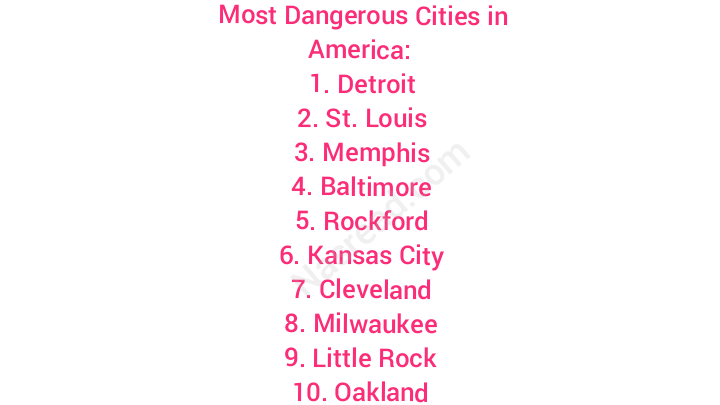Table of Contents
Introduction
The United States is home to many vibrant and diverse cities, but unfortunately, some urban areas experience higher rates of crime than others. In this article, we will explore the ten most dangerous cities in America. These cities have struggled with elevated levels of violent crime, including homicides, assaults, and robberies. It is important to note that crime rates can vary from year to year, and efforts are often underway to address these challenges and improve safety within these communities.
Let’s know most dangerous cities in America.
10 Most Dangerous Cities In America As Per FBI
1. Detroit
Detroit, once a thriving industrial hub, has faced significant challenges in recent years. In 2017, it surpassed St. Louis as the most dangerous city in the country. The number of violent offenses in Detroit increased sharply, driven primarily by a rise in aggravated assaults. With a staggering rate of 2,047 violent crimes per 100,000 inhabitants, Detroit faced an uphill battle in combating crime.
2. St. Louis
St. Louis, known for its high murder rate, has witnessed an increase in recent years. Interestingly, the city’s relatively permissive gun control laws set it apart from other major metropolitan areas. Unlike cities such as Chicago, Detroit, Baltimore, and New York City, St. Louis allows individuals to carry guns in vehicles without a license, according to state laws.
3. Memphis
Memphis, with a poverty rate well above the national average, also struggles with high crime rates. In 2017, there were 1,820 violent crimes reported per 100,000 residents, making it the third-highest rate among major U.S. cities. To address this issue, city officials recognized the need for a larger police force. The force had seen a decline in numbers due to retirement reforms during the Great Recession, leading to a 5.7% decrease from 2008 to 2017.
4. Baltimore
Baltimore experienced a significant increase in violent crime, surpassing the national average by a wide margin. In 2017, there were 1,780 violent crimes reported per 100,000 Baltimore residents, nearly five times the national rate. One alarming statistic is that approximately 80% of gun-related homicides since 2011 have occurred in just 25% of the city’s areas.
5. Rockford
With a rate of 1,659 violent crimes per 100,000 inhabitants in 2017, Rockford became the city with the highest crime rate among those with a population between 100,000 to 200,000. Recognizing the need for enhanced safety measures, the city allocated funds for a gunfire detection program, improved surveillance, and other police technologies.
6. Kansas City
Kansas City has been a significant contributor to the overall increase in violent crime in the country. Between 2015 and 2017, the city experienced an 18.0% spike in violent offenses, significantly higher than the national average. The city faced 129 homicides in a single year, reflecting the challenges it confronts in combating crime.
7. Cleveland
Cleveland struggles with poverty rates higher than the national average, and this is often associated with higher crime rates. Approximately 36.2% of residents live in poverty, while 20.6% of families earn less than $10,000 annually. Unemployment rates are also higher in Cleveland, with a rate of 6.9% compared to the national rate of 4.9%.
In 2017, Cleveland reported 1,631 violent crimes per 100,000 residents, making it one of the highest rates among major U.S. cities. Additionally, the relationship between local authorities and the community has been strained. A 2014 U.S. Department of Justice analysis found that the Cleveland Police Department had engaged in excessive force, violated constitutional rights, and inadequately policed its own officers. Addressing these issues and rebuilding trust between law enforcement and the community remains a crucial challenge.
8. Milwaukee
Milwaukee ranks among the top 15 cities for almost every category of violent crime, including murder, assault, and robbery. With a rate of 547 reported incidents per 100,000 people, it has the fifth-worst burglary rate among major U.S. cities. Cities with high violent crime rates often experience higher rates of property crime as well. The challenge for Milwaukee is to address both aspects and create safer neighborhoods for its residents.
9. Little Rock
Little Rock reported 1,531 violent crimes per 100,000 residents in 2017, earning it the ninth-highest rate among U.S. cities. The city faces a significant issue with aggravated assaults, with a rate of 1,100 per 100,000 residents, four times the national average. In response to the growing crime, the Little Rock Police Department increased its street patrol presence. With 264 sworn officers per 100,000 residents, it had one of the highest police presence rates among cities.
10. Oakland
Oakland reported 1,426 violent crimes per 100,000 residents in 2017, well above the national rate. The city faces a particular challenge with a high incidence of robberies. With 1,623 reported cases of grand theft auto per 100,000 residents, it had a rate almost seven times the national average. Efforts are underway to address crime, with a focus on improving safety and reducing criminal activities in the community.
Read Also: Best Cities In the US For Shopping
Conclusion
Crime rates can vary significantly across cities in the United States, and certain urban areas face more significant challenges in terms of violent crime. Detroit, St. Louis, Memphis, Baltimore, Rockford, Kansas City, Cleveland, Milwaukee, Little Rock, and Oakland are the most dangerous cities in America. Factors such as poverty, unemployment, strained police-community relations, and specific types of crimes, such as aggravated assaults and robberies, contribute to these challenges. However, it’s important to note that efforts are being made in these communities to address these issues, enhance law enforcement strategies, and create safer environments for residents.
You Might Also Like: Most Beautiful Scenic Places In America
Building stronger relationships between law enforcement and the community, investing in crime prevention initiatives, and addressing underlying social and economic factors are all essential for tackling crime and ensuring the well-being of residents in these cities.
